According to Google, 61% of people use a search engine to find home service providers, and 67% of those people did not have a company in mind when doing their search.
The opportunities for your business to win customers on search engines like Google and Bing are massive, but it's important to recognize that your website is the 24/7 storefront that influences potential customers before they reach out to you.
A customer might find your business through an ad on Google, an organic search listing, your Google My Business Profile, or in other places online, but many will end up on your website looking to make sure you solve their problem, are trustworthy and are easy to get ahold of.
But once they get to your website, how well are you doing at converting leads to jobs? And what tools do customers use to convert?
We're going to dive into data from thousands of leads across 16 HVAC companies over a period of 6 months to see how customers converted, how well those leads turned into new work, and how you can maximize your digital real estate to help grow your business.
Customer Behavior is Changing — It's Time to Adapt
You may prefer that every single one of your website visitors converts by calling so that you can get them on the phone to give them your pitch, but the reality is that customers want more options when it comes to getting in touch with your business.
When we observe the behavior of our customers and make changes to accommodate what our customers want, we're likely to see more of our website visitors convert to jobs.
We'll start by first looking at 23,000+ paid advertising leads across 16 HVAC websites with a mix of conversion tools (some without chat and online booking tools):
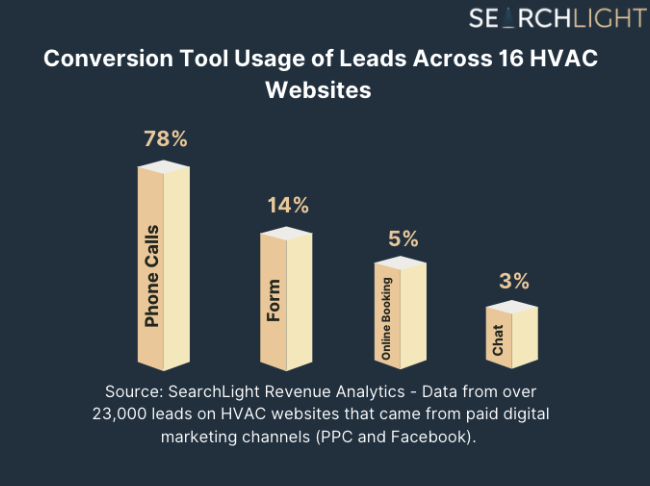
This initial data tells us that phone calls are the most-used method of contacting a home service business, but not all 16 HVAC companies had chat and booking tools on their websites.
Let's break it down further and look at over 16,000 paid advertising leads over a period of 6 months from 5 HVAC companies that did have chat and booking tools on their website.
We found the following:
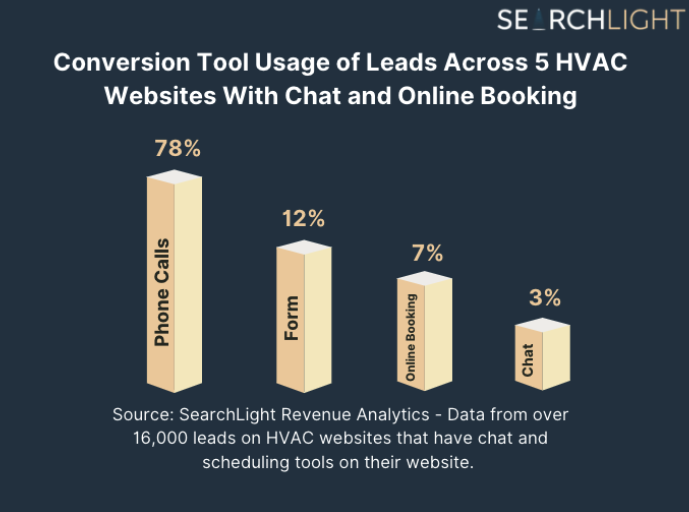
The breakdown is very similar, but when given the option, a higher percentage of leads converted via an online booking tool (7% versus 5%).
While phone calls still dominated the preference for leads to convert, if you look at the percentage of leads that matched to a new opportunity in the CRM broken out by conversion tool, you can see that online booking and chat represent 22% of the total matched leads:
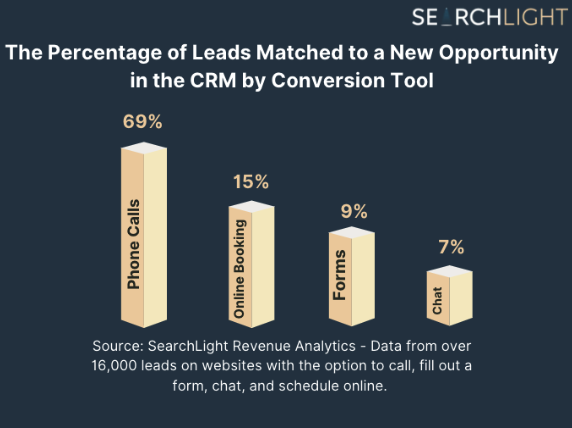
The data shows that HVAC contractors who offer more ways to convert than just form and phone saw 22% of their leads match to new opportunities in the CRM convert via chat and online booking tools.
Leads Matching to New Opportunities in the CRM —What That Means and Why That Matters
In order to measure the quality of leads and how well they turn into booked jobs, you need to measure the step in between, which is matching that lead to a new opportunity in the CRM.
When a customer contacts your home service business, look for a new record from that customer in your CRM to see if a job was created from that lead contact.
The customer may not have booked a job and paid for it, but it does mean that there is a chance for you sell to that customer.
This is important because while some conversion tools have higher lead volumes, fewer of those leads are quality opportunities to close more business.
For example, if you get 1,000 phone calls, but only 10% match to new opportunities in the CRM, that's 100 potential customers you can sell to.
If you get 500 form submissions, but 20% match to new opportunities, that's also 100 potential customers you can sell to.
The numbers look a lot different by conversion tool if you look at leads that matched to opportunities in the CRM for the clients who offered chat and online booking on their website:
3,785 phone calls (29.59% match rate)
824 online booked appointments (72.98% match rate)
471 forms (23.61% match rate)
390 chats (70.65% match rate)
As mentioned before, 22% of leads that matched new opportunities in the CRM came from chat and online booking tools. Those tools saw a significantly higher percentage of leads end up in the CRM with a new opportunity (match rate).
These conversion tools are much more efficient at converting customers into new work (if used properly) than phone and form.
If you're looking for incremental growth, and want an advantage, give your customers more options to contact your business.
22% is not a small number. If you book 100 jobs each month, that's potentially 22 additional jobs if you add more options for your customers to convert on their terms.
Average Ticket by Conversion Tool
Another factor that's important for revenue generation is the average ticket for customers that use various conversion tools.
Across over 5,000 leads that matched to new opportunities in the CRM for the five HVAC contractors that offered chat and online booking on their websites, we found the following average tickets:
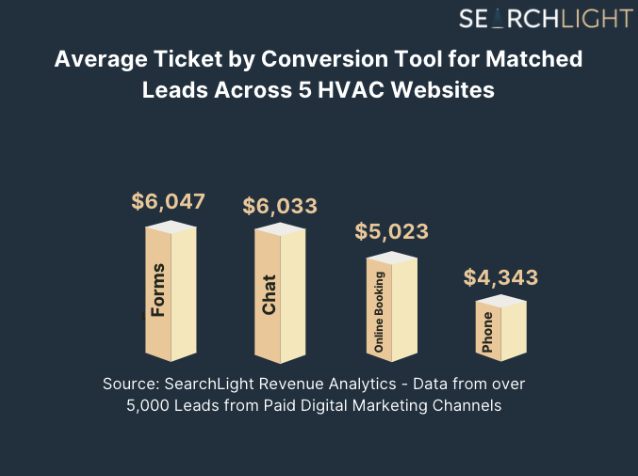
Phone had the highest volume of conversions but the average ticket of those conversions is more than $680 less than appointments booked online.
If you compare conversion tool performance factoring in match rate (the % of those conversions that end up in the CRM and match to new opportunities) and average ticket, you'll realize that you don't need as much volume from online booking and chat to grow your revenue from website visitors.
Let's cap it off by looking at the closed revenue generated from more than 5,000 paid advertising leads across 5 HVAC websites that offered chat and online booking on their websites:
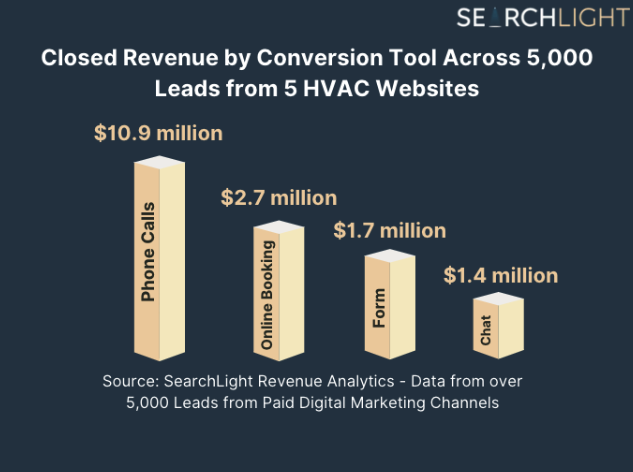
Even though forms had the highest average ticket out of the conversion tools, they had the third-lowest closed revenue because of poor match rates.
Online booking tools generated $2.7 million in closed revenue with a lower average ticket and volume of leads because more of those leads matched to new opportunities in the CRM.
Conclusion
If there's one takeaway from this article, it's that the data from thousands of leads across HVAC websites show that some customers want the convenience of being able to connect with your business how and when they want using forms, chats, and online booking tools.
If you want to convert more of your website visitors into revenue opportunities, add those tools to your website, and make sure your team is prepared to respond to and manage those leads.
Customers have increasingly busy lifestyles and are looking for the quickest, easiest way to get what they want, when they want, however they want it.
We will continually track this data and provide updates as we track the impact of convenient digital booking channels on revenue.


